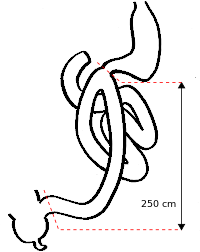SADI-S


SADI-S (Single anastomosis duodeno–ileal bypass with sleeve gastrectomy) is a bariatric surgical technique to lose weight.
The SADI-S is a type of type of bariatric surgery with a single anastomosis. It has a restrictive component when reducing the greater curvature of the stomach, but specially a malabsorptive component, as the common channel is also reduced. The objective of this surgical technique is to lessen the intestinal loop where nutrients are absorbed.
Technique
It can be performed by laparotomy or laparoscopy. A small gastric sleeve is created, by sectioning the greater curvature of the stomach, such as in the Sleeve technique. Subsequently, the duodenum is transected respecting the pylorus. A duodenum-intestinal anastomosis is carried out, 250 centimetres (98 in) from the ileocecal valve. Therefore, the common channel, where nutrients are absorbed becomes 2.5 metres (8.2 ft) long..
Advantages
The SADI-S is a single anastomosis bariatric surgery. It is different than the classic duodenal switch, the gastric bypass (RNY) or sleeve gastrectomy. It is type of bariatric surgery carried out to lose weight.
Disadvantages
Patients may need to take vitamin supplements: A, D, E, K and minerals throughout life. Analytical monitoring is necessary to prevent malnutrition. Stones in the gallbladder, flatulence and diarrhea are more frequent. The surgical risks are the same as in other bariatric techniques, including intestinal perforation, anastomotic leaks, infection, abscess, venous thrombosis and pulmonary embolism. In the long term it can produce a bowel obstruction.
Bibliography
- DeMeester, TR; Fuchs, KH; Ball, CS; Albertucci, M; Smyrk, TC; Marcus, JN (October 1987). "Experimental and clinical results with proximal end-to-end duodenojejunostomy for pathologic duodenogastric reflux". Annals of Surgery. 206 (4): 414–426. doi:10.1097/00000658-198710000-00003. ISSN 0003-4932. PMC 1493213
 . PMID 3662657.
. PMID 3662657. - Payne, JH; DeWind, LT; Commons, RR (August 1963). "Metabolic observations in patients with jejunocolic shunts". American Journal of Surgery. 106: 273–89. doi:10.1016/0002-9610(63)90017-5. ISSN 0002-9610. PMID 14042557.
- Rutledge, R (June 2001). "The mini-gastric bypass: experience with the first 1274 cases". Obesity Surgery. 11 (3): 276–80. doi:10.1381/096089201321336584. ISSN 0960-8923. PMID 11433900.
- Sánchez-Pernaute, A; Pérez-Aguirre, E; Díez-Valladares, L; Robin, A; Talavera, P; Rubio, MA; Torres García, A. (May 2005). "'Right-angled' stapled latero-lateral duodenojejunal anastomosis in the duodenal switch". Obesity Surgery. 15 (5): 700–2. doi:10.1381/0960892053923914. ISSN 0960-8923. PMID 15946463.
- Sánchez-Pernaute, A (2007). "La secreción biliar: en la encrucijada de la carcinogénesis colorrectal" [Bile secretion: At the crossroads of colorectal carcinogenesis]. Revista Española de Enfermedades Digestivas (in Spanish). 99 (9): 487–490. doi:10.4321/S1130-01082007000900001. ISSN 1130-0108.
- Sánchez-Pernaute, A; Rubio Herrera, MA; Pérez-Aguirre, E; García Pérez, JC; Cabrerizo, L; Díez Valladares, L; Fernández, C; Talavera, P; Torres, A (December 2007). "Proximal duodeno-ileal end-to-side bypass with sleeve gastrectomy: proposed technique". Obesity Surgery. 17 (2): 1614–8. doi:10.1007/s11695-007-9287-8. ISSN 0960-8923. PMID 18040751.
- Sánchez-Pernaute, A; Herrera, MA; Pérez-Aguirre, ME; Talavera, P; Cabrerizo, L; Matía, P; Díez-Valladares, L; Barabash, A; Martín-Antona, E; García-Botella, A; García-Almenta, EM; Torres, A (December 2012). "Single anastomosis duodeno-ileal bypass with sleeve gastrectomy (SADI-S). One to three-year follow-up". Obesity Surgery. 20 (12): 1720–6. doi:10.1007/s11695-010-0247-3. ISSN 0960-8923. PMID 20798995.
- Sánchez-Pernaute, A; Rubio, MA; Pérez Aguirre, E; Barabash, A; Cabrerizo, L; Torres, A (September–October 2013). "Single-anastomosis duodenoileal bypass with sleeve gastrectomy: metabolic improvement and weight loss in first 100 patients". Surgery for Obesity and Related Diseases. 9 (5): 731–5. doi:10.1016/j.soard.2012.07.018. ISSN 1550-7289. PMID 22963820.
- Scopinaro, N; Gianetta, E; Civalleri, D; Bonalumi, U; Bachi, V (September 1979). "Bilio-pancreatic bypass for obesity: II. Initial experience in man". British Journal of Surgery. 66 (9): 618–620. doi:10.1002/bjs.1800660906. ISSN 0007-1323. PMID 497645.
- Scott, HW; Law, DH; Sandstead, HH; Lanier, VC; Younger, RK (1970). "Jejunoileal shunt in surgical treatment of morbid obesity". Annals of Surgery. 171 (5): 770–80. doi:10.1097/00000658-197005000-00017. ISSN 0003-4932. PMC 1396821
 . PMID 5445664.
. PMID 5445664.
External links
- Single anastomosis duodeno-ileal bypass with sleeve gastrectomy (SADI-S). One to three-year follow-up.
- Single Anastomosis Duodeno-Ileal Bypass vs Standard Duodenal Switch as a Second Step After Sleeve Gastrectomy in the Super-Morbid Obese Patient (SADI vs CD)